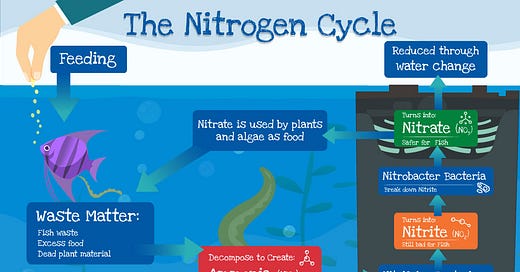Understanding the Nitrogen Cycle: The Foundation of a Healthy Aquarium
The Biological Marvel That Sustains Aquatic Life
The nitrogen cycle is an essential biological process that lies at the heart of every thriving aquarium. As a responsible fishkeeper, understanding this cycle is crucial for maintaining a healthy and balanced aquatic environment. In this blog post, we'll explore the nitrogen cycle, its significance, and the steps to ensure its proper functioning in your aquarium.
1. The Nitrogen Cycle Unraveled
The nitrogen cycle is a natural biological process that converts harmful ammonia, produced by fish waste and decaying organic matter, into less toxic substances. It involves a series of beneficial bacteria that break down ammonia (NH3) into nitrite (NO2) and then into nitrate (NO3). Each stage of the cycle is essential for the well-being of your aquatic inhabitants.
2. Beneficial Bacteria: The Silent Heroes
At the heart of the nitrogen cycle are beneficial bacteria, specifically Nitrosomonas and Nitrobacter. These microscopic wonders colonize your aquarium's filter media and substrate. Nitrosomonas convert ammonia into nitrite, which is still toxic to fish but less harmful than ammonia. Nitrobacter, in turn, convert nitrite into nitrate, which is relatively less toxic and more manageable.
3. The Three Stages of the Nitrogen Cycle
Stage 1: Ammonia (NH3) Production Fish produce ammonia through their respiration and excretion. Uneaten fish food and decaying plant matter also contribute to ammonia levels in the tank. High ammonia concentrations can be lethal to fish and other aquatic organisms.
Stage 2: Nitrite (NO2) Formation Once beneficial bacteria, Nitrosomonas, colonize the aquarium, they begin converting ammonia into nitrite through a process called nitrification. Nitrite is also toxic to fish and can cause significant harm if allowed to accumulate.
Stage 3: Nitrate (NO3) Production The second group of beneficial bacteria, Nitrobacter, take center stage during this stage. They convert nitrite into nitrate, which is relatively less toxic than ammonia and nitrite. However, elevated nitrate levels can still be harmful to fish in high concentrations.
4. The Role of Water Changes
As the nitrogen cycle progresses, nitrate levels may gradually rise. To prevent nitrate buildup, regular partial water changes are crucial. During water changes, a portion of the aquarium water is replaced with fresh, dechlorinated water, effectively reducing nitrate levels and replenishing essential minerals.
5. Establishing the Nitrogen Cycle in Your Aquarium
Cycle Seeding: To initiate the nitrogen cycle in a new aquarium, "cycle seeding" can be beneficial. This involves obtaining beneficial bacteria from an established and healthy aquarium and introducing it to the new tank's filter media or substrate.
Fishless Cycling: An alternative method is "fishless cycling," where ammonia is introduced to the tank (using household ammonia or other ammonia sources) to kickstart the nitrogen cycle. This process allows you to establish the cycle without subjecting fish to harmful ammonia and nitrite spikes.
Conclusion: A Balanced Ecosystem
Understanding the nitrogen cycle is a fundamental aspect of responsible fishkeeping. By allowing the beneficial bacteria to thrive, we create a balanced ecosystem where toxic ammonia and nitrite are converted into less harmful nitrate. Regular water changes play a vital role in maintaining healthy nitrate levels and sustaining the well-being of our aquatic friends.
As guardians of these captivating underwater worlds, let us embrace our role in nurturing the nitrogen cycle. With knowledge, care, and a deep respect for the intricacies of nature, we ensure that our aquariums become havens of thriving life and serene beauty.




